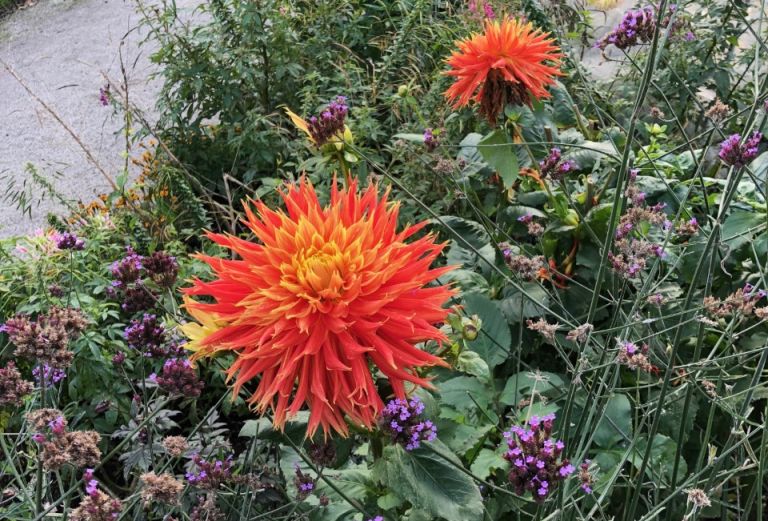
Written by Patricia Stadler, garden apprentice
Dahlia flowers are part of our perennial corners in our vegetable beds at Fulham Palace. And they are by far one of our favourite show stoppers!
And after the seasonal preparation of our dahlias in the walled garden, we ate some! But before I start passing the salt, this piece will explain a bit more about this stunning flower. And the work it takes to care for these beauties over the winter, ready for them to appear again in their full colourful glory.
Dahlia blooms come in a variety of shapes, colours, and sizes. Pollinators are attracted to them in the garden due to their bright, bold colours – not their scent. These herbaceous perennials have a remarkably long blooming season and preserve their beauty for a long time after they have been cut and put in a vase. No wonder our Dahlia bouquets get snapped up so quickly when they appear on the market barrow!
Now that the colder months have arrived, we are excited by the idea that we will see them blooming again next summer. To ensure they will thrive again, we overwinter our Palace garden dahlias. This means we keep the plants in a particular place to protect them from the elements. This helps us prepare these beautiful tuberous plants to return in the warmer months.
Dahlias are native to Mexico and Central America and are related to sunflowers, daisies, and zinnias. The Aztecs called them ‘acocotli’ (meaning water cane) in reference to the plant’s hollow stem, that they then used to transport water. This inherent characteristic of the plant means that overwintering is vital for dahlias during the colder months. Damage to the plant from heavy frost is irreversible, as the water-filled cells of the plant burst. The end result is mushy, soft, and rotten roots.
After the first light frosts, we cut back the dahlias’ dying foliage and carefully dig up their roots. We plant our dahlias in two types of areas in the walled garden. Some are planted near the south-facing area protected by the walls, as it is sheltered enough for the overwintering process. British winters have become milder. And the soil is sandy in the area they are planted, keeping it well-drained for the dahlia tubers to stay where they are. As extra protection for them over winter, we add a thick layer of mulch to cover their crowns.
Unsheltered dahlias planted in our vegetable beds need a different process to overwinter. We lift them out of their beds, brush them down, and dry them overnight before labelling and positioning them in pots or crates. Next, we cover them with dry soil, ready to store in our dark, dry, and warm potting shed. When Spring arrives, and after the last frost, the dahlia tubers will sprout in their containers, ready to be planted straight away in a garden bed.
Dahlia roots are storage tubers. This means the plant has thick roots where it can store food to survive when they are dormant. They are not reproductive tubers like potatoes. Instead, dahlias have their nodes situated on their crown close to the stem, where all the root tubers join. Unlike a potato, which sprouts from several nodes on the tuber, the thick root of a dahlia detached from its crown is unviable and will not grow.
Within Aztec communities, those unviable tubers were a source of food. Waste not, want not, we decided to try them ourselves! The juiciness and crunchiness of home-baked dahlia fries surprised us all. The flavour can be best described as a marriage of parsnip and kohlrabi.
So, when you are lifting your dahlias and find some are not viable, why not peel, chop, bake and give those tubers a taste test!
The walled garden is open between 10.15 – 15.45 during winter.
Why not come and see what we’re doing over winter in the garden?



